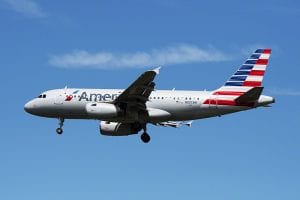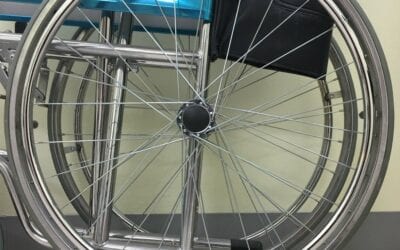Some parents continue to endanger infants by flying them on their laps.
 While flying during the COVID pandemic, I’ve seen parents try to evade the face mask mandate for their children while other parents try to fly with their infant or toddler in their lap, likely in order to save money. Both can have disastrous consequences and endanger infants.
While flying during the COVID pandemic, I’ve seen parents try to evade the face mask mandate for their children while other parents try to fly with their infant or toddler in their lap, likely in order to save money. Both can have disastrous consequences and endanger infants.
Parents won’t get flight crews to ignore passengers, even toddlers who don’t follow face mask requirements. Moreover, parents can’t successfully hold children of any age safely in their lap during severe turbulence or a survivable emergency. These child safety issues are clear, especially the one about holding lap children.
Parents cannot guarantee child safety when infant children are in their laps during severe turbulence or a survivable emergency.
For child safety while flying, the American Academy of Pediatrics (AAP) recommends that “children less than 40 pounds be securely fastened in certified child restraints [in their own airplane seat] when flying.” Children who weigh 40 pounds or more can safely sit in a regular airplane seat using its seat belt.
The Federal Aviation Administration (FAA) permits parents to hold their children under two years of age in their lap. However, the AAP states, “An unrestrained passenger of any age faces a higher risk of death or injury in a survivable crash or severe turbulence than passengers who are strapped into safety seats or belts.” Parents should purchase and use appropriate child car safety seats, which have FAA approval, for their youngsters weighing less than 40 pounds while flying with them. This is the best way to guarantee child safety.
Airlines and flight crews are tired of having to deal with passengers who refuse to comply with the federal COVID face mask mandate.
Airlines and their flight crews are fed up with passengers and families who won’t comply with the federal COVID face mask mandate.They’ll give you an earful. Since the start of 2021, the FAA has received about 3,300 reports of face-mask-based unruly passenger behavior. Many of these passengers, including children, who have refused to wear any face mask or wouldn’t wear one properly, have been put on airline no-fly lists. Delta alone has more than 1,600 former passengers on their no-fly list.
It’s hard for young children to behave for long periods of time, particularly when stuck in a cramped cabin, where they must sit for hours. Having to wear a face mask has made it even harder for children on airplanes. More than ever, parents need to help their children understand what’s expected of them while on their plane flight and how important it is that they listen to you. It’s likely going to be difficult for young children. But parents must help them successfully cope with the rules and regulations every minute of their flights. Most parents have figured out what they must do.
It’s critical that parents understand what’s required for child safety. The U.S. COVID face mask mandate states that:
• Everyone two years of age and older must wear a face mask at all times in airports and while inflight.
• Masks may be removed briefly to eat, drink, or take medication, but the mandate specifically warns: “Prolonged periods of mask removal are not permitted for eating or drinking; the mask must be worn between bites and sips.”
Parents aren’t being permitted to evade the face mask mandate for their children by trying to continuously give them small drinks and snacks during their flight.
Parents can’t circumvent the mandate by attempting to feed their children “continuously” for much of their flight, by having their youngsters take a sip or two of juice or a bite of a snack every few minutes. Flight crews have seen that too often and are directed to not permit it. Flight crews that I’ve seen are somewhat forgiving of children taking a brief pause between sips and bites, so they don’t have to constantly remove and replace their masks. They rightly don’t give that leeway to adults who are trying to “game” them.
• Note that foreign airlines outside of the U.S. may have different face mask age requirements than U.S. airlines.
• Some types of face masks aren’t permitted by U.S. airlines for children or adults, such as bandannas, scarves and masks with valves. On many foreign flagged airlines, cloth masks are banned and only surgical, N95 and KN95 face masks are allowed.
If you and your children are flying internationally, make sure you thoroughly understand the face mask requirements mandated on those flights.
Parents need to prepare for flights with their children by having them practice wearing masks and having enough diversions on board their flight to take their attention from the masks and the flight.
I have two major tips for parents with children who must be masked while flying.
1. Particularly if your child isn’t used to wearing a mask for a prolonged time, such as in school, practice wearing a mask with them for at least as long as your expected flight. Talk to them about it to prepare them for the flight. Take a driving trip in which you have them mask-up while in the car, while you do the same, to practice for your flights.
2. Make sure you have plenty of snacks, games, books, their favorite pillow and blanket, electronic devices with their favorite videos, etc., on your flights as diversions. If you take their minds off their face masks, the flight will be easier for them and you.
Planning can mitigate many potential problems you might encounter when flying with your children. Every child, regardless of age, should have their own seat. Parents should use a safety seat for their children weighing less than 40 pounds. Even if you don’t favor the face mask mandate, have your entire family obey the mandate to avoid problems on your flights and allow everyone, especially your children, to have a great time.
(Image: American Airlines A319 landing at Philadelphia International Airport. Copyright © 2018 NSL Photography. All Rights Reserved.)
After many years working in corporate America as a chemical engineer, executive and eventually CFO of a multinational manufacturer, Ned founded a tech consulting company and later restarted NSL Photography, his photography business. Before entering the corporate world, Ned worked as a Public Health Engineer for the Philadelphia Department of Public Health. As a well known corporate, travel and wildlife photographer, Ned travels the world writing about travel and photography, as well as running photography workshops, seminars and photowalks. Visit Ned’s Photography Blog and Galleries.



